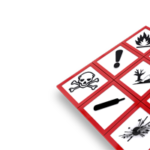Overview
Fire safety in science, technology, engineering, and mathematics (STEM) and Career and Technical Education (CTE) laboratories extends far beyond fire extinguishers and emergency exits. It begins with the very foundation of the learning environment: its design, occupancy, operations, and daily practices.
Two central standards that shape safe laboratory infrastructure and processes are NFPA 45 and NFPA 101. NFPA 45 provides specific guidelines for fire protection in labs using chemicals, while NFPA 101 addresses building safety, including safe exit pathways, occupancy limits, and emergency preparedness across all instructional spaces [1][2].
As hands-on lab instruction expands, the operational complexity and risk also increase. This is particularly evident in overcrowded or under-supervised laboratories with flammable chemicals and specialized equipment. A 2020 study in Nature Chemistry reported that 25% of researchers had not been trained on the specific hazards they worked with (which is a direct violation of the Occupational Safety and Health Administration’s [OSHA] Hazard Communication Standard), 27% did not conduct risk assessments prior to experiments, and up to 38% had experienced accidents or injuries that were never reported to a supervisor. Academic institutions were identified as the least compliant in these areas [3][4].
These figures reflect a measurable gap between evolving laboratory practices and consistent implementation of risk management protocols.
Designing for Safety: Building Codes and Fire Standards
A safe laboratory begins with intentional design rooted in compliance. NFPA 45 outlines requirements for laboratory classification, construction materials, fire suppression systems, and ventilation for chemical storage and handling. NFPA 101 complements this with broad building safety measures, such as maintaining adequate means of egress, fire-rated construction, and emergency lighting [1][2].
Proper lab design must consider location-specific requirements for chemical quantities, gas storage, and flame sources. Facilities teams and STEM instructors should collaborate to understand how fire codes apply to their respective lab spaces. For example, a biosafety cabinet must never house open flames or flammable gases, and the structural integrity of fire-resistant barriers must remain intact [1].
Guidance from professional and academic bodies helps interpret how fire standards can be effectively integrated into modern lab operations [5]. These interpretations are particularly valuable during the design and renovation phases, when decisions about ventilation, flame sources, chemical storage, and safe circulation routes must align with both NFPA 45 and the practical needs of instructional environments.
Overcrowding and Space Constraints in STEM Labs
One of the most overlooked yet significant fire risks in STEM and CTE laboratories is overcrowding. When class sizes exceed a lab’s physical capacity, the instructor’s ability to monitor experiments diminishes, and safe evacuation becomes compromised. Research shows a statistically significant relationship between square footage per student and incident rates in instructional spaces [6].
Professional guidelines from the National Science Teaching Association (NSTA) recommend a minimum of 60 square feet per student to maintain safe and effective instructional conditions [6]. Enforcing occupancy limits based on these benchmarks is critical for compliance with fire codes, real-time hazard prevention, and instructor oversight [7][8].
Several reports highlight the urgent need to prioritize safety over enrollment growth, recommending enforceable policies on classroom capacity, infrastructure improvements, and instructor-to-student ratios [9][10]. The National Science Teaching Association sets a recommended cap of 24 students per lab session to ensure instructors can provide adequate supervision and maintain safe practices [8]. Many labs operate in aging facilities with insufficient ventilation, outdated emergency systems, and chemical storage that no longer meets modern standards. These conditions significantly elevate fire and injury risk if not addressed alongside rising enrollment [10].
Internal Lab Inspections and Preventive Measures
Routine internal inspections are among the most powerful tools for maintaining a fire-safe lab. A thorough inspection process should cover the following key areas:
- Chemical Storage and Labeling
When improperly stored, incompatible chemicals can cause fires or explosions. Chemicals must be segregated by hazard class, clearly labeled, and stored in approved containers. Flammables should be placed in fire-resistant cabinets. - Gas Cylinder Management
Flammable, oxidizing, or corrosive gases must be stored upright, secured, and regularly inspected for leaks. Improperly managed gas cylinders can quickly escalate minor incidents into major emergencies. - Electrical Safety
Frayed cords, exposed wiring, and overloaded circuits are common ignition sources. Visual inspections should be performed regularly, and damaged equipment must be removed from service immediately. - Flame Use in Biosafety Cabinets
Open flames and flammable gases should never be used in biosafety cabinets. Doing so undermines the airflow integrity and introduces a high risk of ignition within confined spaces. - Egress and Fire Door Integrity
Exit doors should never be propped open, and exit routes must be kept clear at all times. Blocked corridors delay evacuations and violate fire code standards. - Fire Extinguishers and Emergency Equipment
Each lab must have fire extinguishers appropriate for the materials used. The path to this equipment must remain unobstructed, and all staff should be trained in its use. - PPE and Safety Protocol Adherence
Lab coats, gloves, and goggles must be matched to the hazard profile of the experiment. Proper PPE reduces injury in the event of thermal or chemical exposure [1][11].
Lab managers and instructors should develop internal fire safety audit tools that are reviewed regularly and customized for the specific risks of their instructional environments.
Evaluating Experimental Chemical Hazards
Not all experiments carry the same level of fire risk, which is why pre-experiment evaluation is essential. Begin with a thorough review of the Safety Data Sheets (SDS) for all chemicals in use. Assess the risk associated with each piece of equipment, particularly heating devices and fragile glassware. Factor in the student population: Are students capable of understanding and responding to safety risks? Have they received appropriate training?
Pre-lab run-throughs, age-appropriate instruction, and the reinforcement of emergency procedures (such as safety shower use) should be integrated into every high-risk activity. The Chemical Safety Board and the American Chemical Society offer joint guidance on managing these hazards in academic environments [12][13].
The National Science Teaching Association also emphasizes the integration of safety considerations into early science education, preparing students to understand laboratory risks as part of their scientific literacy [14].
From Design to Daily Practice: Embedding Fire Safety in Labs
Effective fire safety in STEM and CTE labs begins at the architectural blueprint and extends into everyday teaching and operations. Overcrowded classes, outdated inspection protocols, and poorly vetted experiments can all heighten the risk of fire. By aligning with national fire protection standards such as NFPA 45 and NFPA 101 and regularly auditing internal procedures and instructional practices, educational institutions can build a safety-first culture that protects students, staff, and infrastructure.
Proactive risk management today means fewer emergencies tomorrow. Resources from public-interest organizations also emphasize the importance of integrating fire prevention education throughout K–12 science curricula [15]. Schools should take the initiative to review their lab spaces, reevaluate occupancy limits, and retrain staff on emerging safety protocols.
References
1. National Fire Protection Association (NFPA). 2024. “NFPA 45: Standard on Fire Protection for Laboratories Using Chemicals.” Accessed July 21, 2025.
2. National Fire Protection Association (NFPA). 2024. “NFPA 101: Life Safety Code.” Accessed July 21, 2025.
3. Ménard, A. Dana, and John F. Trant. 2020. “A Review and Critique of Academic Lab Safety Research.” Nature Chemistry 12 (1): 17-25.
4. Hazard Communication, 29 CFR § 1910.1200 (2024).
5. Palluzi, Richard P. 2017. “Making Sense of Laboratory Fire Codes.” Chemical Engineering Progress 113(7):54-9.
6. National Science Teaching Association (NSTA) Safety Advisory Board. 2020. “Overcrowding in the Instructional Space.” Accessed July 21, 2025.
7. Roy, Kenneth. 2023. “Occupancy Load in STEAM Instructional Spaces.” Accessed July 21, 2025.
8. Safer STEM. 2024. “Occupancy Load and School Science Laboratories: Ensuring Safety in Educational Spaces.” Accessed July 21, 2025.
9. National Science Teaching Association (NSTA). n.d.”Science/STEM Instructional Space Requirements” Accessed July 21, 2025.
10. Love, Tyler S., Kenneth R. Roy, and Sandra Sturdivant West. 2024. “A Call to Prioritize Safety in STEM and CTE: Addressing Overcrowded Classes and Other Critical Safety Issues.” Laboratories 1(1):52-8.
11. Zuccarello, Dan. 2024. “Driving Excellence: The Role of Internal Lab Audits.” Lab Manager, May 9. Accessed July 21, 2025.
12. U.S. Chemical Safety Board and American Chemical Society. 2018. “Back to School Safety: The Importance of Laboratory Safety in the Classroom” Accessed July 21, 2025.
13. Palcik, James. 2024. “Ensuring Safety in Elementary Science and STEM Activities: Hazards, Risks, and Better Professional Safety Practices.” Accessed July 21, 2025.
14. National Science Teaching Association (NSTA). 2020. “Safety and the Next Generation Science Standards.” Accessed July 21, 2025.
15. National Science Teaching Association (NSTA). n.d. “Safety in Elementary Science” Accessed July 21, 2025.







